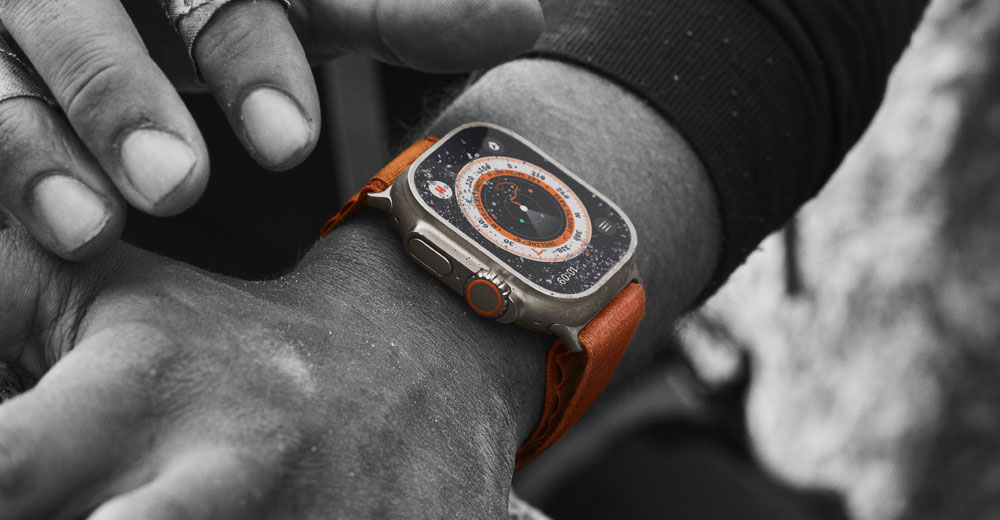Apple refreshed its iPhone, Watch, and AirPods product lines at an online event Wednesday, as well as introducing a new Ultra watch for activity in challenging environments.
The Apple Watch Ultra is designed to operate in extreme cold and hot environments, as well as under 130 feet of water. It’s housed in a rugged titanium case, and its face is made of tough sapphire crystal.
Ultra also has an “Action” button that’s programmable, an 85-decibel siren for emergencies, and its controls are designed for use with gloves. It has three microphones for voice call clarity, even in windy conditions.
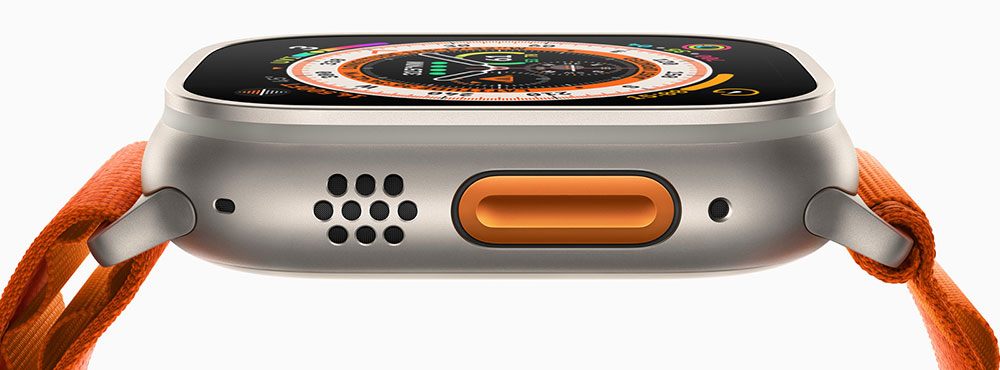
Apple Watch Ultra programmable Action button (Image Credit: Apple)
Cellular is built into the Ultra, which has a battery life of 36 hours on a single charge, although Apple promised that will be boosted to 60 hours with new battery optimization software available this fall.
In addition, Ultra supports dual-frequency GPS, and with the Dive Plus app can be turned into a scuba diving computer.
The Ultra will sell for US$799 and will be available Sept. 23.
“I’m a scuba diver, and I’ve had multiple dive watches that were well over $1,000,” said Tim Bajarin, president of Creative Strategies, a technology advisory firm in Campbell, Calif.
“Here you’re getting a dive watch and everything else, plus cellular for $799,” he told TechNewsWorld. “That’s a really good deal.”
“It’ll be a big hit among extreme sports enthusiasts and scuba divers,” he added.
Crash Detection
Ross Rubin, the principal analyst at Reticle Research, a consumer technology advisory firm in New York City, called the Ultra a “statement product.”
“It shows that the Apple Watch can be used in harsh environments by people engaged in extreme activities,” he told TechNewsWorld.
“It isn’t something that mainstream people need, but you can see how some of the technology, like the action button, may filter down to future iterations of other models,” he added.
Apple also rolled out its Series 8 Apple Watch at its pre-taped event. The watch sports a new temperature sensor, which can be used by women to track ovulation. Ovulation is typically measured with a thermometer and journal. The new watch makes that task a lot easier and more convenient by providing automatic retrospective ovulation estimates.
“The Apple Watch has morphed into a digital-health wearable solution,” Mark N. Vena, president and principal analyst at SmartTechResearch in San Jose, Calif., told TechNewsWorld.
The watch, as well as the new iPhones, also has a new crash-detection feature. When a crash is detected, the watch will automatically connect with emergency services, provide the location of the crash, and notify the emergency contacts on the watch.
To create the feature, Apple added two new motion sensors to the Series 8, an improved three-axis gyroscope and a high G-force accelerometer. The accelerometer can measure up to 256 Gs, allowing it to detect the extreme impacts of a crash.
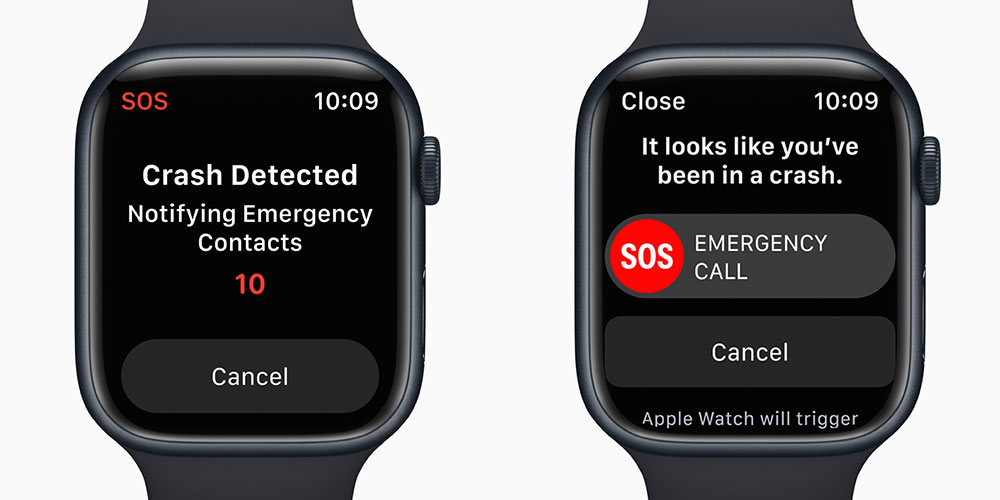
Crash Detection uses an advanced sensor-fusion algorithm and a new, more powerful accelerometer and gyroscope in Apple Watch to detect and deliver car crash alerts. If a user is unresponsive after a 10-second countdown, the device will dial emergency services. (Image Credit: Apple)
The feature runs only when a user is in a moving vehicle and gathers data only around the time of a possible crash.
“Apple Watch isn’t just for health, but it’s also for safety,” Bajarin observed.
Series 8 watches have an 18-hour battery life, but with a new low-power mode feature, battery life can be extended to 36 hours.
The Series 8 will be available Sept. 16. The GPS version is priced at $399, and the cellular version at $499.
Satellite SOS
During its online event, Apple also introduced the iPhone 14 Pro, with a 6.1-inch display, and Pro Max, with a display of 6.7 inches.
The Pro models, as well as the 14 and 14-plus models, support a new Emergency SOS service via satellite. Special antennas have been built into the new iPhone models to enable them to send text messages to high-flying satellites.
To aid in the connection, software on the phone shows a user where to point their phone to connect to the satellite and to stay connected as the satellite moves.
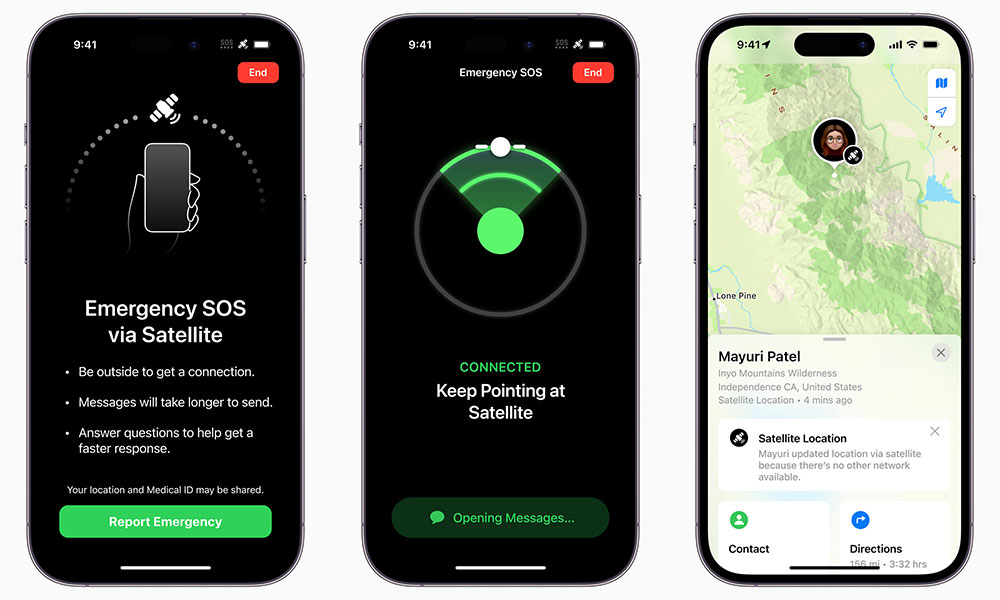
The iPhone 14 lineup introduces Emergency SOS via satellite. The feature enables users to message emergency services when cellular or Wi-Fi coverage is not available. (Image Credit: Apple)
Because of the narrow bandwidth involved in satellite communication, Apple created a custom, short-text compression algorithm to reduce the average size of a message by a factor of three.
Initially, the satellite service will be limited to the United States and Canada, where it will be offered free for two years.
“The satellite phone feature will have tremendous value for a lot of people,” Vena said.
“It would have been the perfect phone for Tom Hanks in the movie Castaway,” he joked. “If he had the iPhone 14, though, it would have been a very short movie.”
Bajarin declared that Apple is blazing a new path in personal safety and protection. “It’s going to be a bigger part of their DNA going forward,” he maintained.
“The satellite features in the iPhone 14 Pro set a new precedent in smartphones,” he added.
DSLR Challenger
Apple has also upgraded the cameras in the new pro models. The main camera on the back of the unit has a 48-megapixel sensor, with support for a fast f/1.78 lens, while the front camera has a 12MP sensor, with an f/1.9 lens. The main camera also supports the ProRaw format.
The Pro models also have a new chip, the A16. “With the A16, Apple has the most powerful smartphone camera on the market right now,” Bajarin said.
“The 48 megapixels and ProRaw capabilities bring the iPhone 14 Pro series much closer to a true DSLR,” he added.
Vena noted that Apple is shooting for beyond parity with digital single-lens reflex cameras. “It is clear that Apple doesn’t want the camera in its phone to be the equivalent of a DSLR, but they want it to be superior in many ways to a DSLR,” he observed.
The upgrade of the front camera in the new iPhones represents another change in Apple’s thinking about the cameras in its phones, he added. “It used to be that the back camera was the most important camera,” he said. “They now see the front camera and the back camera with equal importance.”
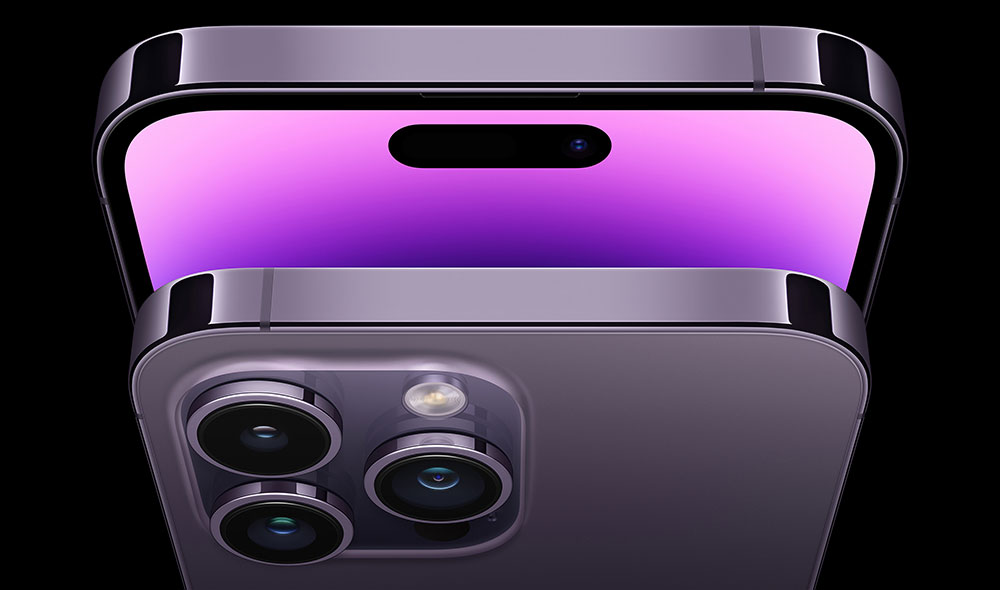
The iPhone 14 Pro and iPhone 14 Pro Max feature the first 48MP camera on an iPhone. (Image Credit: Apple)
Apple has made great strides in video stabilization with the Pro and Max models. “You can literally take video on the run with very little shaking of the image,” Rubin noted.
The often-maligned notch on the front of the Pro and Pro Max models has been turned into a dynamic notification center. “They’ve turned it into a benefit rather than a detraction,” Rubin said.
The iPhone 14 and iPhone 14 Plus will be available in five colors: midnight, blue, starlight, purple, and (Product)Red. iPhone 14 Pro and iPhone 14 Pro Max will be available in four colors: space black, silver, gold, and deep purple.
The iPhone Pro 14 will sell for $999, and the Pro Max for $1,099. The iPhone 14 will sell for $799; the 14-plus for $899. All will be available Sept. 16.
Better AirPods
Apple also introduced a new version of its AirPods Pro, with a new H2 chip, longer battery life, and noise cancellation technology that’s two-times more efficient than its predecessor in blocking noise.
It’s also improved the “transparency” mode of the earbuds by filtering out some of the disruptive noise that would ordinarily be heard with noise cancellation turned off. “I haven’t seen other earbuds do that,” Rubin observed. “It addresses one of the disadvantages of transparency mode. You let the whole world in, including the harsh noises.”
The new AirPods Pro will go on sale Sept. 23 for $249.
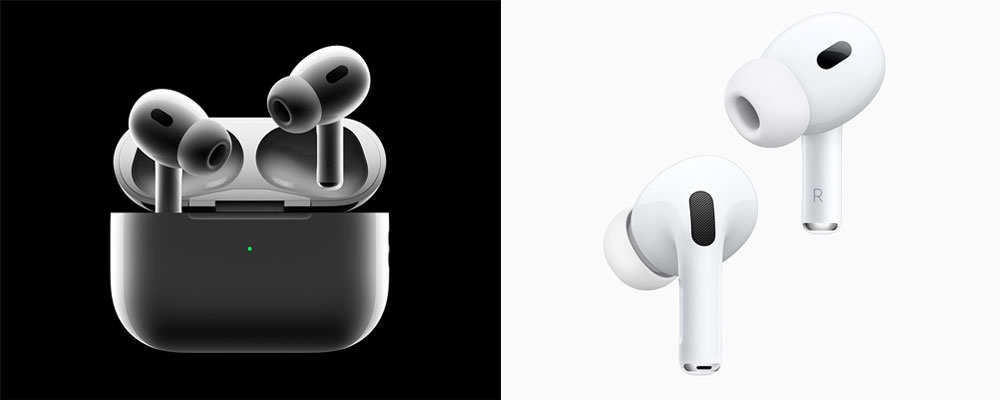
AirPods Pro bring upgrades to Transparency mode, Spatial Audio, and convenience features while canceling up to twice as much noise over their predecessor. A new low-distortion audio driver and custom amplifier offer richer bass and crystal-clear sound. A new extra-small ear tip can deliver a better fit to more users. (Image Credit: Apple)
“Most of these devices are just upgrades,” asserted Jim McGregor, founder and principal analyst at Tirias Research, a high-tech research and advisory firm in Phoenix.
“The only one that has a new usage model is the Apple Watch Ultra,” he continued. “Some of the features they’re advertising in the iPhone 14 and iPhone 14 Plus have been on Android phones for three or four generations.”
“It’s getting harder for Apple and everyone else to justify these annual upgrades,” he added. “I will give Apple credit, though. I’m happy to see they’re offering these products in a reasonable price range, and they’re not trying to offer a $2,000 smartphone.”

